Notes
The Mind of Skinheads: What the Racist is Expected to Look Like
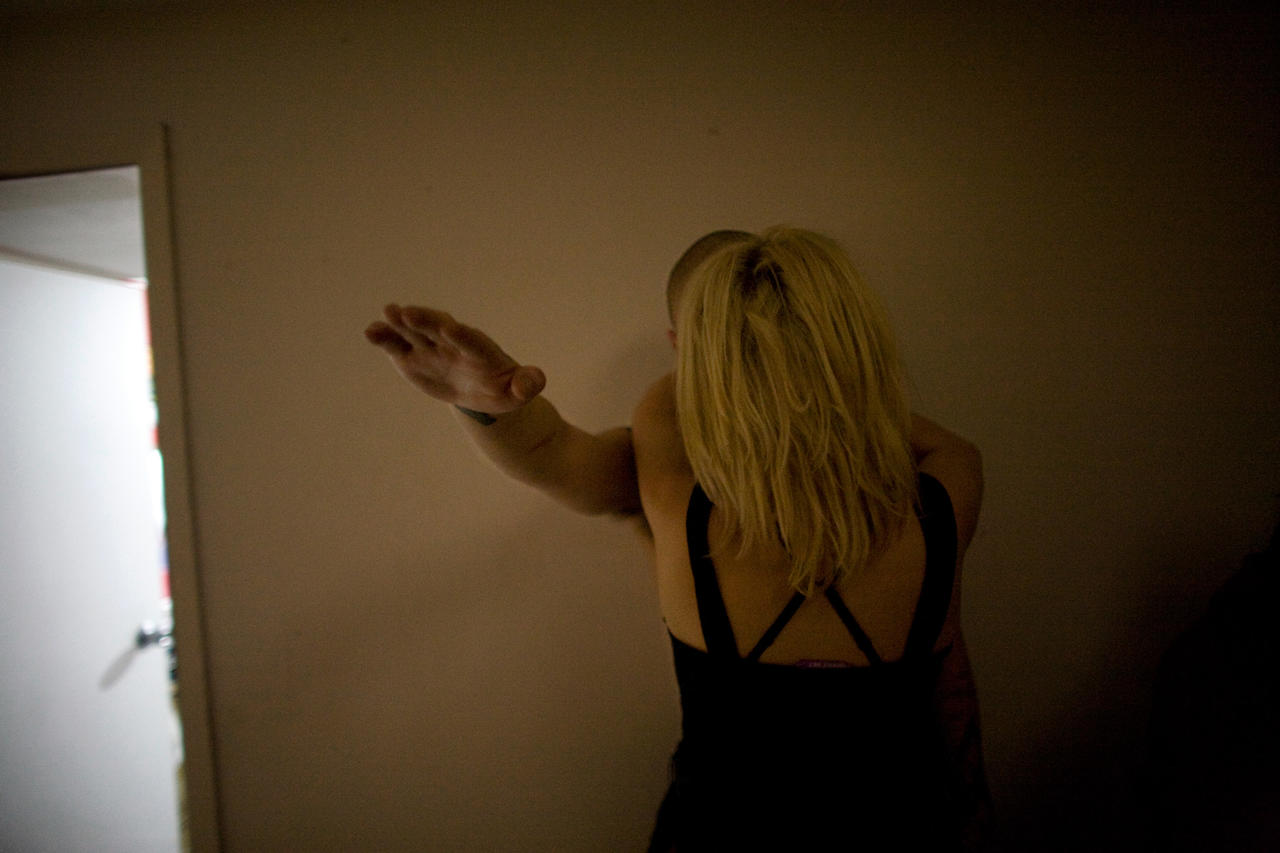
The dark roots give her away; she is not a natural blonde. We don’t know why she has chosen to dye her hair, but for men like her boyfriend, hairstyle (shaved bald, or nearly) is a cosmetic expression of an ideological commitment. They are skinheads.
She is identified only as the girlfriend of a man named Rob, who extends his arm toward the camera in a “Seig Heil” while they are “making out.” She, wearing a black tank top and a black racerback bra, its tag just visible, has Rob pressed up against a scuffed wall. He is shirtless, and his reaching fingers seem almost to graze the lens of the camera. He is visibly tattooed; she, with both arms wrapped tight around his neck, is not. One corner of the photo is shadowy, but a door to their right opens on to a different room with much brighter light. Just as the doorway promises use a peek into a hidden space, these photographs purport to reveal what the world looks like from “Inside the Mind of a Skinhead.” But all the photo really shows us is the kiss, its haunting combination of the romantic act with the violent gesture. We don’t (we couldn’t) truly see ‘inside the mind of a skinhead.’ Instead, the photos give us a window on their personal lives, and the dysfunction that we see becomes a representation for their abhorrent beliefs.
This photo, and nine others like it, form the image gallery for an article by Brett
Gundlock. Gundlock describes himself as a photographer “drawn to marginalized and alienated groups,” but says that his interest here was much more in the “lifestyle” of his Neo-Nazi subjects than their ideologies. He writes in the nearly-neutral style of a journalist, leaving it to his readers to moralize against white supremacy. Save for an image in which one bare-chested man restrains another, looking dazed, against a blood-smeared wall after a fight, the images are surprisingly devoid of violence.
In the text, Gundlock emphasizes the importance of family and community in the skinhead movement, observing that they “work hard to craft the next generation.” This description makes the skinheads seem more human, more relatable. But the photos work against that by emphasizing the unsavory conditions in which this hard work happens. They live in dwellings that are inhospitable. The men interact with one another in physically intense, vaguely sexual ways, and relate crassly to women. As they hint at forms of squalor—literal or figurative—these images reanimate motifs from the origins of social documentary photography.
The earliest adherents of this genre were inspired by Progressive Era reformism. They fanned out into urban slums and rural hovels, intending to capture the hardscrabble daily lives of their inhabitants. Smaller, faster cameras afforded adventurous photographers the necessary mobility; eventually, flash technology enabled them to penetrate dark and otherwise inaccessible spaces where seamy nightlife unfolded. Collections like Jacob Riis’s How the Other Half Lives, published in 1890, combined visual and textual depictions of cramped and unsanitary housing, reliance on the income of laboring children, and non-traditional gender roles or family arrangements. The intended audience for such images was far removed from these conditions. The images in “Inside the Mind of a Skinhead” rely on similar visual shorthands.
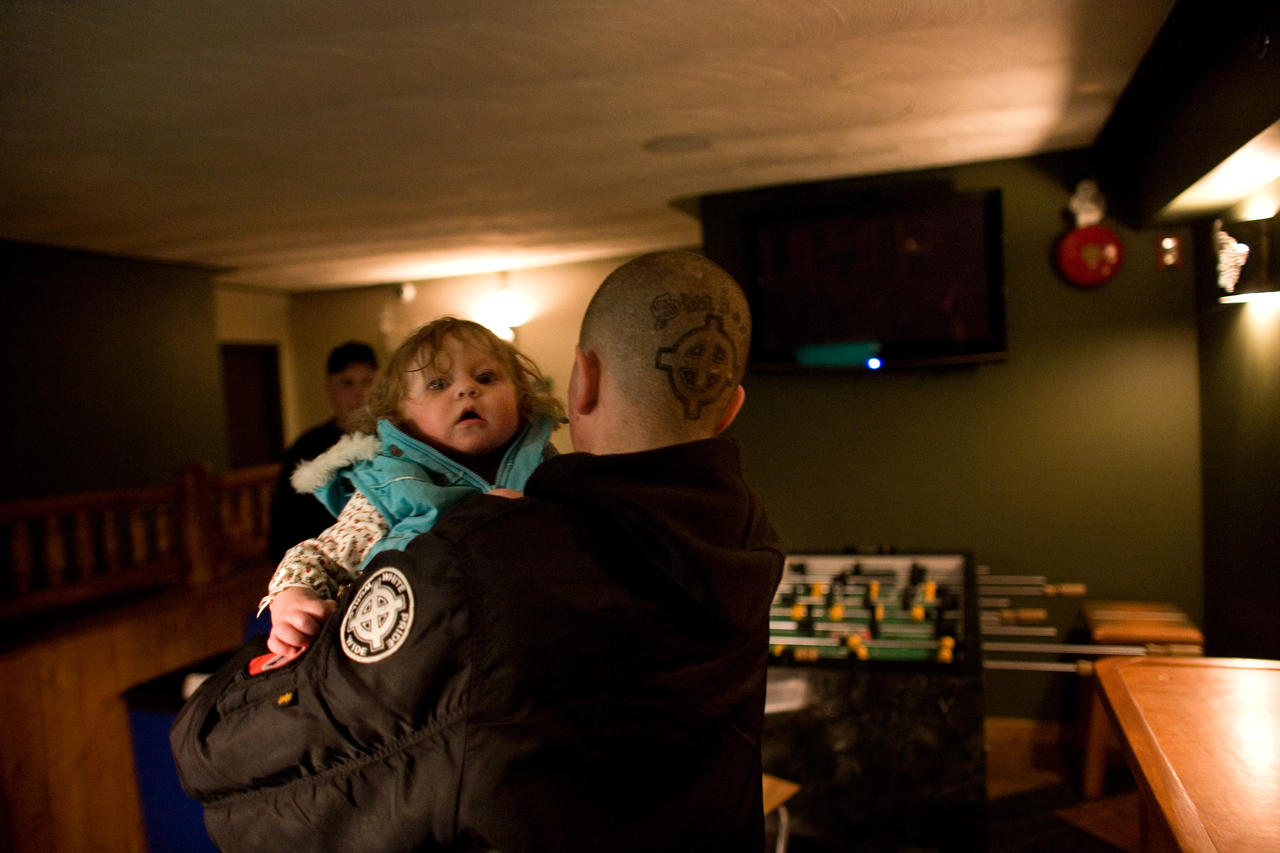
Gundlock amplifies unsettling content with aesthetic choices. The light in the photos is often poor or sickly. The shots are often a little bit out of focus or off-kilter. And the subjects, even when their faces are visible, do not look directly at the camera. The only exception is a young girl, with her eyes wide and her mouth agape, who seems to be making direct, if uncomprehending, eye contact with the camera and the viewer. She is peering over the shoulder of the unrelated man who is carrying her around, her expression evocative of a Diane Arbus portrait. He is dressed in black, with matching white power insignias tattooed on his scalp and stitched onto the arm of his jacket. With her blond hair and blue eyes, she is the picture of innocence, and so serves to heighten the contrast with the darkly-clad men in the frame.
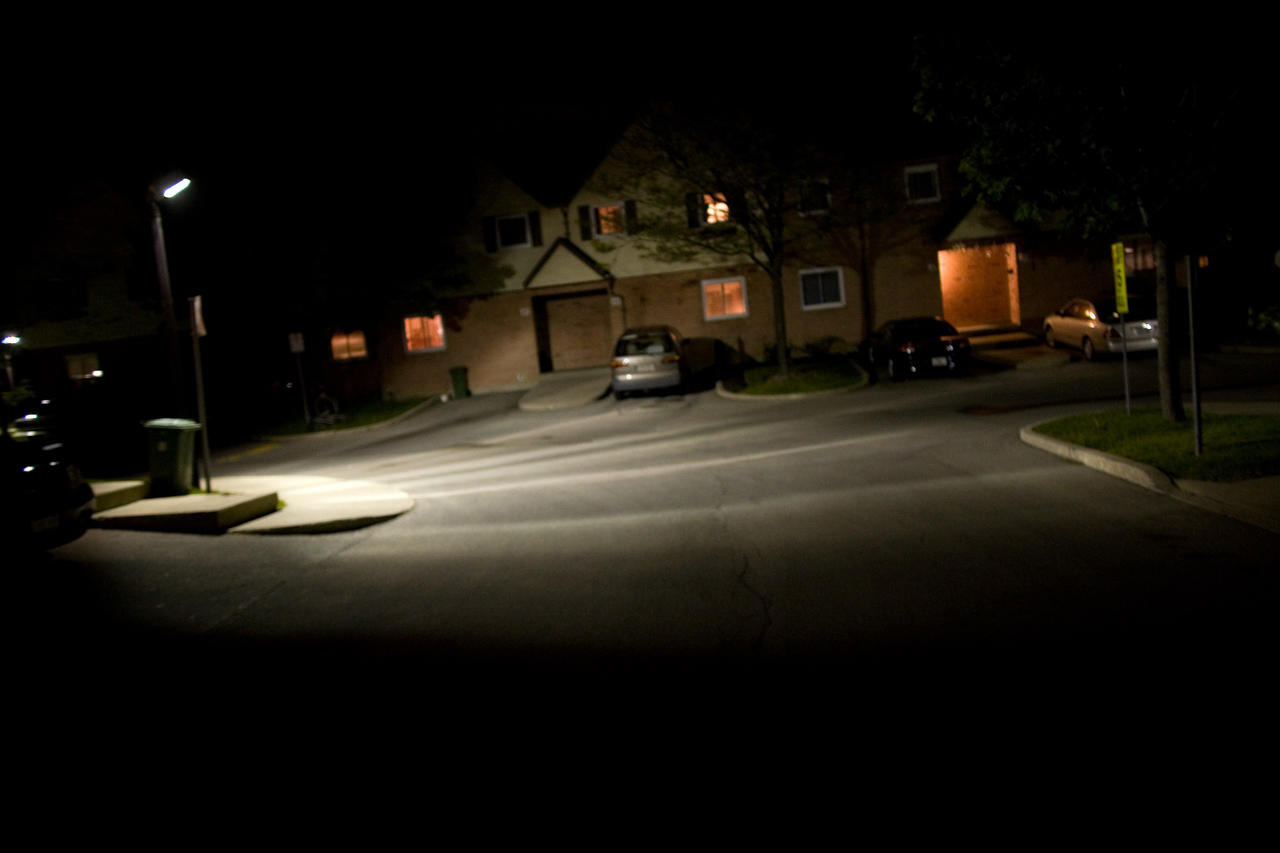
The second shot in the piece is an exterior view of an otherwise unremarkable multi-family dwelling. The homes don’t look inviting, necessarily; they are nondescript, functional, fronted by a parking lot dotted with small islands of grass, a tree or two. But neither are there any visible signs that this is a ‘bad’ or violent neighborhood. The caption tells us only that this is a “skinhead’s house in Hamilton.” The main light in the photo, cold and bluish, is cast by a streetlamp. A large green trash can rests against the lamp, highlighted by it. The trash can hints at how we might understand the people inside the house (white ‘trash’), despite it looking respectable enough from the outside. The photo itself is tilted to the left, to unsettling effect.
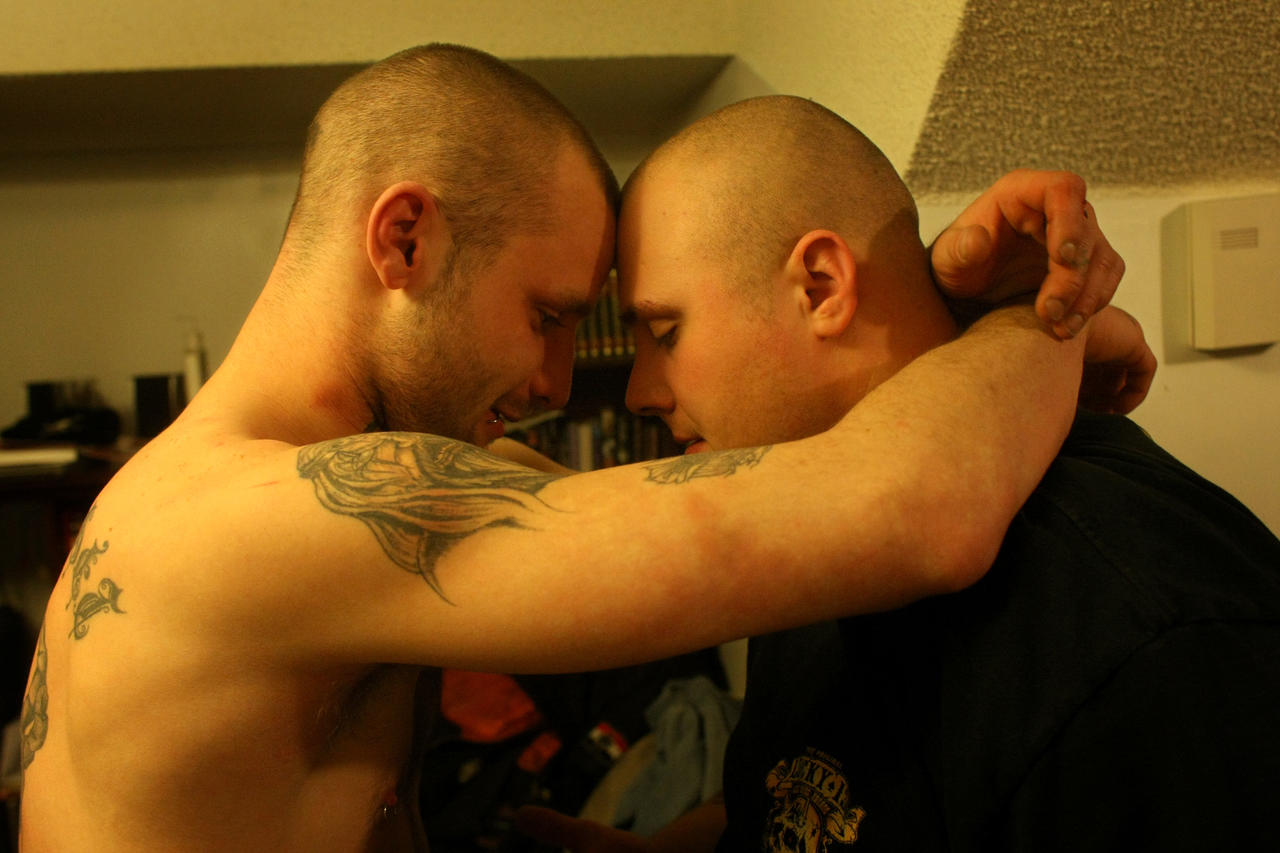
Through Gundlock’s camera, the skinhead world emerges as profoundly homosocial, in that it emphasizes strong bonds between men. Many of their interactions appear sexual, hinting at a homoerotic current in the community. The men, if they are indoors, are often shirtless, or nearly so, and touch each other freely. The first photo in the story shows two men in profile, both named Tyler, their foreheads touching as one—bare-chested—embraces the other with a smile as that man looks down dreamily. The caption tells us that they are talking, that they’ve been drinking. But it also looks like they are leaning in for something more intimate, like a kiss.
The relationships between men are frequently coded as gay, while the heterosexual relationships between men and women are often portrayed as perverse, lacking the obvious affection that binds the men. There is the “Seig Heil” makeout. And the young girl, born to two Neo-Nazis, in the photo I described above, is being carried by a man who is not her father; there is no mention of where her parents might be.
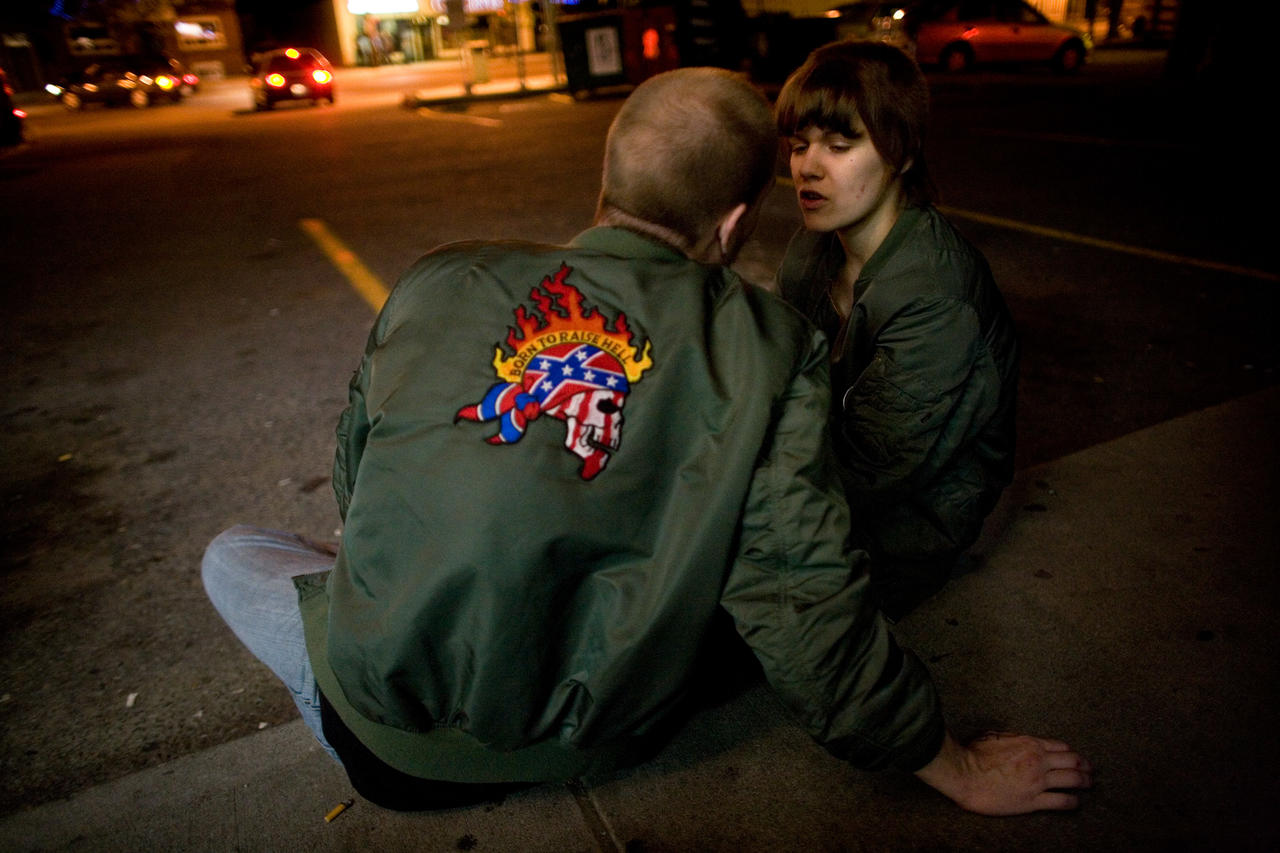
Another shot freezes a couple—Richard and Izzy, wearing satiny green bomber jackets—in mid-argument. They are sitting on a dirty-looking curb, seemingly at home among the cigarette butts and discarded chewing gum. The quarrel suggests that their relationship is conflicted. And the public location (they are essentially ‘in the gutter’) reveals that they do not know, or do not care about, norms about the kinds of behavior that ought to be kept private. The patch on the back of Richard’s jacket (a flaming skull in a Confederate flag bandanna) proclaims him “born to raise hell.” This hints that Neo-Nazism is in his genes, as if he is the product of a bad reproductive match, destined for this kind of life.
Early social documentarians curried shock and revulsion to elicit viewers’ sympathy. They operated in recognizable spaces, like family homes, so that their well-to-do audiences would be able to get their bearings and interpret what they were seeing. But this also enabled them to discern the differences between their own homes and families and those of the other half, who might have tried, and failed, to emulate their higher standards. Gundlock’s images rely on similar forms of recognition. In making this claim, I’m not arguing that his subjects deserved ‘better’ or more generous depictions. But I do think this is a problematic way of attempting to make racism visible, particularly because the images rely on loaded signifiers of gender, sexuality, and class. In this way, the photos suggest that only ‘those’ people are racist, reassuring the rest of us that if we don’t live or look like that, we must not be. And so this visual strategy risks distracting from all the other ways that white supremacist thinking might be perpetuated in much lovelier environments.
— Rebecca Adelman
(Photos: Brett Gundlock Caption: Rob “seig heil’s” while making out with his girlfriend. Caption 2: Conor carries another skinhead’s daughter. The young girl’s parents were both members of the Neo-Nazi group. Caption 3: A skinhead’s house in Hamilton. Caption 4: Tyler and Tyler talk while drinking. (The subjects preferred not to have their last names published.) Tyler (left) was convicted of second-degree murder and given life in prison after he and a fellow skinhead beat a man to death in Calgary. Caption 5: Richard and Izzy argue in front of a local pizza shop.)


Reactions
Comments Powered by Disqus